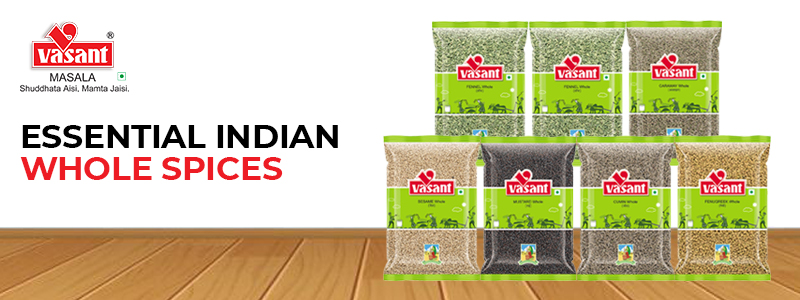
In terms of tastes, spices and aroma, the Indian culinary tradition is the most versatile and eclectic. The nation is generally regarded as one of the world's spice capitals. The origins of our dishes are very important to our traditions.
Every Indian family is familiar with the spice box, a collection of all the essential spices that may work their culinary magic on nearly any Indian meal. The knowledge of adding Indian spices to flavour cuisine has been passed down through several generations. Spices are high in vitamins, minerals, and other vital nutrients, in addition to having strong taste and aromatic characteristics.
One of the most frightening aspects of making Indian food is the enormous array of spices used — both whole and ground, which are frequently mixed into complicated spice mixes. Here are the most significant among the huge variety of whole spices, which enhance dishes and recipes while providing excellent health and medical advantages.
Black Pepper:
Black pepper is indigenous to India, namely the Western Ghats and Malabar. It is an unusually hard spice since it depends on several natural cycles, such as rainfall, which is why fresh pepper costs fluctuate considerably. Black pepper, as its production depends on several conditions, is one of the most costly spices of all. It was a time when it was as costly as gold, and thus the 'black gold' was named. Black pepper must be roasted, like other spices, before mixing. But fresh black pepper can also be incorporated into recipes for its fresh aroma and flavour.
Cumin Seeds:
Cumin is often used whole and roasted to lend Indian recipes a distinctive smokey flavour. The unique ridged brown grains and the strong smell of this plant can be recognised, even from far away. Sometimes it's mistaken for fennel, caraway and anise seeds, but when you look at it (brown rather than green fennel), you can recognise the difference in colour and flavour (smoky, as opposed to a stronger liquorice taste). For the most intense taste, cumin is used freshly. One thing to remember while dry-roasting this spice is that it burns rapidly, and burnt cumin tastes unpleasant and will be highly noticeable in your meal.
Mustard Seeds:
Mustard seeds are used interchangeably in Indian cooking and can be yellow, black, or brown. When mustard seeds are crushed or fried in oil, their taste is released. Their smokey, nutty taste is a must-have in curries and curry powders, and mustard oil is widely used in northern India. Mustard seeds are beneficial to cardiovascular health, provide relief from cough and cold symptoms, promote hair development, and include calcium, zinc, and dietary fibre, as well as magnesium and iron.
Fenugreek:
Fenugreek is a spice that gives Madras curry powder its extremely distinctive, earthy and robust "curry" smell. The seeds are yellowish and resemble little kernels of wheat. Fenugreek leaves are also dried and used as spices (usually Kasuri methi). Fenugreek seeds are extremely fragrant and should be handled carefully. They are also employed in traditional medicine to produce imitation maple syrup, and oddly enough.
Fennel:
Fennel seeds have an uncanny similarity to black liquorice. For Tarkas and many other Indian cuisines, it is an excellent seasoning element. They are also used after meals as a mouth freshener. They have a very nice scent and both culinary and medicinal properties. Seeds of fennel can treat indigestion, strengthen bones, and prevent cancer. They are a good source of vitamin C.
Thymol:
Carom seeds and Ajwain are other names for these seeds. Ajwain is a fantastic spice! The taste is so strong that it cannot be consumed alone or uncooked. Even though they appear to be seeds, these are really dried fruits. Every seed has a considerable amount of thymol, giving it a taste comparable to thyme but considerably stronger. Ajwain is high in monosaturated fatty acids. It prevents premature greying of the hair, relieves acidity and gas, and cures asthma and chronic cough.
Coriander Seeds:
Cilantro emits coriander seeds. Coriander has a lemony fragrance with hints of green and woody undertones. It is a key spice in the areas of Madras and Vindaloo, where it pairs beautifully with sour components in recipes. They can be ground before adding to a sauce or used to flavour oil before adding other cooking ingredients. It improves blood circulation in the body and has excellent cooling effects.
To shop all these Indian Whole Spices, visit Vasant Masala's e-store. We have all these spices and many more spices that are essential in cooking Indian cooking.
Related: Authentic Indian Spices- A Complete Beginners Guide

